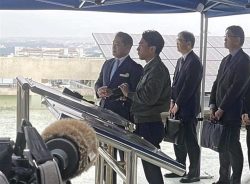
Homeroom teacher Tatsumi Ogawa listens as children speak at Gosho-Minami Elementary School on Nov. 10, 2023. Ogawa summarized the children’s comments on the board and rarely interrupted.
8:00 JST, February 3, 2024
Children learn best when they interact with adults. When teachers, parents and other adults in the community are actively involved with children, real-world exploratory learning becomes deeper and more fulfilling. To ensure rich learning, it is important for communities and schools to build good relationships.
Gosho-Minami Elementary School in Kyoto City is a good example of such a school, where teachers have developed a dynamic integrated studies program in collaboration with the local community. In November of last year, elementary school teachers from around the country gathered at this municipal school to observe its classes and share their findings.
“Integrated studies” is an approach to cross-curricular learning that is being implemented in elementary and junior high schools in Japan. Children can learn problem-solving skills by working on various projects related to real-life issues. At Gosho-Minami Elementary School, I observed a fourth-grade class.
The homeroom teacher, Tatsumi Ogawa, 29, started the class by simply asking the question, “So, what are we going to do today?”
“To make the street near the school lively, we need to figure out what to do next,” some of the children replied, to which the others agreed. Then Ogawa asked, “Can we start right away?” All hands went up, and the discussion began.
Ogawa asked the occasional question, but gave hardly any instructions. However, the children all knew what needed to be done. Various ideas were suggested, such as doing a quiz rally to make the street better known to more people and installing stylish lanterns so that people could come even at night. They discussed the strengths and weaknesses of their ideas.
In the discussion, the children thought hard about it as an issue of concern to themselves. Their faces were full of confidence. At a review meeting after the class, one of the visiting teachers asked at what point the teacher would intervene in the children’s discussion. Ogawa replied, “I try not to come out and force my ideas on them.”
The school was established in 1995 through the merging of neighboring schools and began researching integrated studies in 1997. This was before integrated studies time was formally introduced in the National Curriculum Standards. After much trial and error, the school decided to set a different theme for each grade: The third grade focuses on “Kyoto,” the fourth grade on “festivals,” the fifth grade on “jobs,” and the sixth grade on “living together.”
Historically, there is a strong sense among local residents that “this school is our school.” About 150 years ago, when Kyoto was in decline after the capital was moved to Tokyo during the Meiji Restoration, the local people, feeling a sense of crisis, decided to establish schools by pooling funds by themselves to nurture the human resources needed to support the community. Those schools are the forebears of Gosho-Minami. In 2002, a community organization to support school operations was established when the government asked Gosho-Minami and some other schools to study a new school format.
This community organization now consists of six committees: learning support, library, physical and verbal expression, town planning, welfare, and sports and health. Over 65 coordinators plan and organize events such as a midsummer festival with Bon dancing, a “Winter College” with various study games, and weekend tours of the Kyoto City Zoo’s backyard. More than 200 local adults, such as store owners, dance instructors and craftsmen, serve as “community teachers,” speaking about the community and its traditions and culture for integrated study classes. Adults with affection for the community support the children, hoping that they too will develop affection for the community.
The children’s academic performance is remarkable. In the latest results of the National Assessment of Academic Ability, Kyoto ranks first among 20 ordinance-designated cities, and Gosho-Minami significantly exceeds the average for the whole city. The Gosho-Minami district is now known as a desirable place to live for those who have children. It seems that not only academic skills but also so-called noncognitive abilities are being developed.
Principal Tomiyo Suzuki, 58, explains: “By interacting with various adults other than teachers and parents, a sense of belonging and attachment to the community and school is born. Children can learn with confidence, and the empathy of children is also nurtured by the influence of empathetic adults who welcome anyone.”
Hirohisa Nagaya, 54, chairman of the school management council (the community decision-making body) and owner of a company that sells school uniforms, also says: “The children are gaining the ability to listen to and summarize a broad range of others’ opinions, to find what they love, and to immerse themselves in it. I believe that such abilities will be useful in various situations when they enter society in the future.”
Gosho-Minami’s education system has helped establish the concept of a “community school.” The idea is to promote school development by bringing schools and communities together through the use of community voices and educational resources. According to the Education, Culture, Sports, Science and Technology Ministry, 16,131 public elementary and junior high schools nationwide, or 58.3% of the total, have introduced community school systems.
Among schools operated by the community, some parents and local residents have very strong influence, and the principal only implements decisions made by the school management council. There have been cases where the council holds the power to decide even who the principal will be, leading to frequent changes in leadership.
Some may say that the strong influence of the community can ensure the consistency of school management when the principal changes. The problem is that while education in schools must be future-oriented, advice from the community is sometimes misguided and backward-looking. The reason is that their views are often based on their own past educational experiences.
As has been noted in OECD reports, people outside of schools, such as parents and local residents, present the greatest resistance to education reform around the world. They often oppose attempts to cut content because they believe that what they themselves learned years earlier is important, even if it is considered out of date. At the same time, advances in science and technology and the development of globalization have led to an ever-increasing amount of new content to be taught, creating a situation known as curriculum overload around the world.
The current National Curriculum Standards, which began to be phased in from fiscal 2020, clearly state that schools should be open to society in order to adapt to the future. To this end, principals should always consider what society will be like in the future and how children can thrive. Adapting to such changes in society and future predictions, principals are expected to review and revise the curriculum constantly.
It is not enough to faithfully implement the National Curriculum Standards. Technologies such as ChatGPT, which now have a significant impact on what humans should learn, did not exist when the current standards were formulated.
Everyone with a stake in education should look beyond their personal educational experience and into the future. Let us then share a common vision of future society and future children with our principals and teachers. Through this cooperative effort, we can build better schools and foster richer learning experiences for our children.
Political Pulse appears every Saturday.

Makoto Hattori
Hattori is a staff writer in the Education News Department of The Yomiuri Shimbun
"Editorial & Columns" POPULAR ARTICLE
-

Artificial Intelligence Expands Possibilities for Foreign Language Learners
-

Build Intellectual, Physical Strength, As Well As Communicative Power / Japan Should Move from Beneficiary to Shaper of World Order
-

Global Economy in Turmoil: Prevent Free Trade System from Going Adrift / Risks to Financial Markets Must Be Heeded
-

Rice Coupons: A Misguided Approach to Countering Rising Prices
-

Japan-China Strain Set to Persist as Beijing Officials Self-Interestedly Bash Tokyo; Takaichi Unlikely to Back Down
JN ACCESS RANKING
-

As Chinese Tourists Shun Japan, Hotels and Stores Suffer
-

Tokyo Economic Security Forum to Hold Inaugural Meeting Amid Tense Global Environment
-

Osaka-Kansai Expo’s Economic Impact Estimated at ¥3.6 Trillion, Takes Actual Visitor Numbers into Account
-

BOJ Gov. Ueda: Highly Likely Mechanism for Rising Wages, Prices Will Be Maintained
-

Japan Govt Adopts Measures to Curb Mega Solar Power Plant Projects Amid Environmental Concerns























